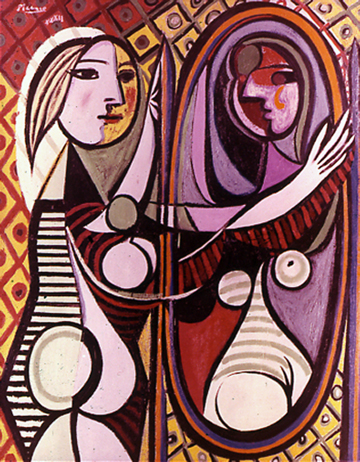As is well known, Picasso’s core inspiration was rooted in sexual energy, especially women’s bodies. At the same time, his daring explorations into what we later called cubism was compatible with his interest in African masks, shapes and colors, that he had absorbed into his work for years.

Pablo Picasso ‘Girl before a Mirror’, 1932, oil on canvas, 64” x 51 l/4”
Not so well known, what passes as pure play subtly masks Picasso’s sophisticated understanding of the inner-and-outer nature of human consciousness that animates all creative energy, including human sexual energy. In so many ways, Picasso’s compositions reflect this duality, as canonized in his graphic work such as The Dreams and Lies of Franco, the Minatormachia etchings, many of his portraits, but hidden as well in the playful ways he reveals the paradoxes of ordinary life in the simplest drawings.
In The Girl Before a Mirror, one is literally looking at two images, the observer (left) and the reflection (right). The observer owns (holds) the inner image as her own, so in a way the portrait is still one person: dark and light, inner and outer, good and (maybe) evil, even life and death. As I contemplate the painting I have much to ponder about my own inner-outer personality.
Yet just when my brain is seduced by such an elegant philosophical meaning embedded in this complex painting, Picasso’s colorful childlike tumbler-design of balls and ovals and tiles explodes into nonsense, and I am returned to joyful delight. Picasso was a master artist at work on many levels at once, but always returns his viewer to the essential life force of art as play.
Picasso was a transformational artist because he opened the twentieth century with a challenge to the rather stuffy and linear nature of western art history, by giving us all totally new spaces to be personal and playful, to step across historic contexts, to mix and explore different media and art styles. Most serious artists are lucky to open even one new point of view in a lifetime of work. Picasso opened whole landscapes of possibility for us all.



